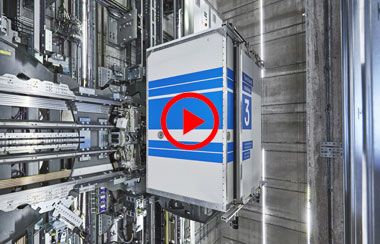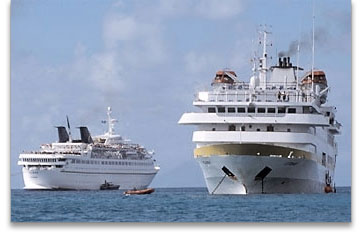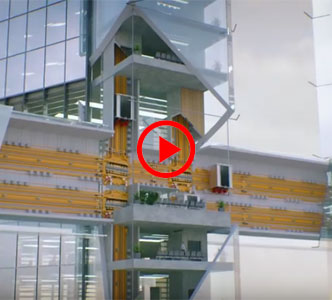
|
In this issue: Featured video: To view newsletter in your browser click here. |
 |
| Watch the video |
|
See tthe video: Sources: |
The elevator has been called the most-used mode of human transportation. Until now it has changed little since its inception. Elevators are known to have existed since about the 3rd century BC. More modern elevators were created in the 1800s. Until now the technology that is used to move them has advanced from a rope pulled by a person or animal, to one or more steel cables attached between the elevator cab and a motor. A new elevator called MULTI is transformational and is being demonstrated in an 807 ft test tower in Germany. This April, ground was broken for a similar 18-shaft tower and innovation complex in Atlanta, GA to be completed in 2021, by multi-national company ThyssenKrupp. It will be next to SunTrust Park where the Atlanta Braves play. The MULTI has no cables to support and move it. Instead it relies on linear motors, which work on electro-magnetic induction like an AC motor, except that the motion is linear instead of rotary. In an AC motor the rotor spins within a surrounding band of powered electromagnets that are static and called the stator. In a linear motor, the stator is ‘unrolled’ making it linear and in some cases superconducting magnets are used. MULTI elevators are envisioned by the manufacturer to enable new building and city designs with multiple elevator cabs in each shaft traveling around vertical and horizontal “loops” as well as across sky-bridges connecting buildings. Specifications for the MULTI include a top speed of 13.4 mph, 50% more transport capacity at up to 70% less peak power than conventional elevators, no limit on height, up to 50% less shaft space and waiting times reduced by an average of 15 to 20%. Regarding safety, ThyssenKrupp states that, “the linear motors are safe because they need to be energized before they move. That means that without energy, the cabins can’t move. That’s why the cabins include batteries in case of energy breakdown. Additionally, we use a multi-step braking system that doesn’t allow cabins to move freely.” |
| Position Sensor Speed | |
|
You may have an application that doesn’t seem to have relatively high-speed requirements. It doesn’t mean you shouldn’t be concerned with how fast a sensor can provide position or other information. The reason is that just because you have a value available from a device doesn’t necessarily mean that value is accurate or current.
With traditional mechanical track and wiper sensors, the shaft can be turned as fast as the application needs. However, there are still limits to how fast a rotary sensor’s shaft, for example, can be turned and still provide position information that is within accuracy specifications. As an example, one mechanical wiper/track product’s speed is specified at up to 120 RPM another is 400 RPM. Obviously neither approach even 1,000 RPM let alone tens of thousands. With rotary sensors that operate using a magnetic sensing principle, they are often using digital electronics converting analog information to digital (A/D). For analog outputs on these devices, a D/A converter is used to convert back to analog after digital processing.
|
These devices have limits on their analog movement acquisition time and A/D conversion and storage time. Collectively these are called signal propagation delays.
Maximum sample rates on magnetic encoders or sensors can be 1, 2, 5 or even 15 kHz. Better manufacturers will also specify a propagation delay so that a user will know to allow for that amount of time before a freshly acquired change in input is available at the output of the device. This could be hundreds of microseconds, milliseconds and even tens of milliseconds. If the propagation delay is long enough, a sensor that has a seemingly high speed response may not be able to provide accurate data if the application’s rate of change is faster than half the time of the propagation delay. |
|
|
|
 Marine Drive Systems Control Marine Drive Systems Control |
 Ship designers have found that they can save space while getting exceptional accuracy and reliability for their command and control feedback sensors used in marine drive systems. Ship designers have found that they can save space while getting exceptional accuracy and reliability for their command and control feedback sensors used in marine drive systems.
Cruise ships often have complex drive systems that are much more than an engine or two turning propellers through underwater drive shafts. Some have what is called pods that can rotate a limited number of degrees to steer the ship by changing the direction of the propellers. Some have half their propellers facing towards the aft of the ship (facing forward) and half away from the aft to increase forward or reverse thrust and maneuverability. Cruise ships that have fixed propellers, likely have side-facing thrusters to increase their maneuverability in tight spaces such as when docking. Engines can sometimes be a combination of diesel and electric or gas-turbine and electric. Many types of cruise ships require pod or rudder position information in order to steer the ship and/or coordinate usage of multiple propellers simultaneously. By designing in the Vert-X 51 non-contact position sensor, used on the cruise ships shown here, ship designers have a certified marine-grade watertight sensor that measures to 14-bits and provides 360° range and switch point outputs making additional relay-control circuitry unnecessary. Sources: https://www.cruisemapper.com/wiki/752-cruise-ship-engine-propulsion-fuel |

|
If you have a question about position sensors for your specific application, Novotechnik engineers would be glad to speak with you. Contact us at Email Novotechnik [email protected] or call 800-667-7492. Please email suggestions for technical subjects you would like to suggest for this newsletter to this link: Newsletter Editor [email protected] |
